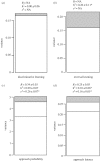Heritabilities and co-variation among cognitive traits in red junglefowl
- PMID: 30104430
- PMCID: PMC6107570
- DOI: 10.1098/rstb.2017.0285
Heritabilities and co-variation among cognitive traits in red junglefowl
Abstract
Natural selection can act on between-individual variation in cognitive abilities, yet evolutionary responses depend on the presence of underlying genetic variation. It is, therefore, crucial to determine the relative extent of genetic versus environmental control of these among-individual differences in cognitive traits to understand their causes and evolutionary potential. We investigated heritability of associative learning performance and of a cognitive judgement bias (optimism), as well as their covariation, in a captive pedigree-bred population of red junglefowl (Gallus gallus, n > 300 chicks over 5 years). We analysed performance in discriminative and reversal learning (two facets of associative learning), and cognitive judgement bias, by conducting animal models to disentangle genetic from environmental contributions. We demonstrate moderate heritability for reversal learning, and weak to no heritability for optimism and discriminative learning, respectively. The two facets of associative learning were weakly negatively correlated, consistent with hypothesized trade-offs underpinning individual cognitive styles. Reversal, but not discriminative learning performance, was associated with judgement bias; less optimistic individuals reversed a previously learnt association faster. Together these results indicate that genetic and environmental contributions differ among traits. While modular models of cognitive abilities predict a lack of common genetic control for different cognitive traits, further investigation is required to fully ascertain the degree of covariation between a broader range of cognitive traits and the extent of any shared genetic control.This article is part of the theme issue 'Causes and consequences of individual differences in cognitive abilities'.
Keywords: affective state; animal cognition; cognitive judgement bias; cognitive repeatability; heritability; learning.
© 2018 The Author(s).
Conflict of interest statement
The authors declare no competing interests.
Figures



References
-
- Shettleworth SJ. 2009. Cognition, evolution, and behavior, 2nd edn Oxford, UK: Oxford University Press.
-
- Wasserman EA, Zentall TR. 2009. Comparative cognition. Oxford, UK: Oxford University Press.
-
- Carere C, Maestripieri D. 2013. Animal personalities: behavior, physiology, and evolution. Chicago, IL: The University of Chicago Press.
Publication types
MeSH terms
Associated data
LinkOut - more resources
Full Text Sources
Other Literature Sources

